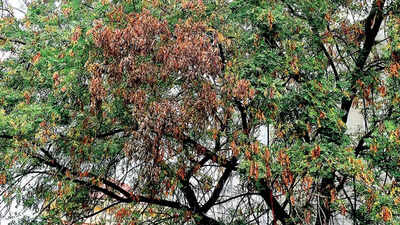Top Searches
- News
- City News
- Hyderabad News
- After Karnataka & Andhra Pradesh, neem trees in Telangana hit by ‘dieback’ disease
After Karnataka & Andhra Pradesh, neem trees in Telangana hit by ‘dieback’ disease
After Karnataka & Andhra Pradesh, neem trees in Telangana hit by ‘dieback’ disease

A neem tree affected by dieback, a fungal disease. The disease causes the tree to dry up
HYDERABAD: After causing havoc in Tamil Nadu, Karnataka and Andhra Pradesh, ‘dieback’, a fungal disease, is now inflicting neem trees in Telangana.
Thousands of trees have been hit badly in Warangal, Hyderabad, Rangareddy, Medchal, Mahbubnagar, Gadwal and other districts. A neem tree begins to dry up and its yield is hit once the fungus infects the tree.
Ironically, neem that has become synonymous with providing good health to other trees, animals and people through its twigs, leaves, flowers, bark, seeds and fruits has been dying due to the rare pest first identified about three decades ago. Neem is a natural pesticide and now it has become a victim of the pest that attacks only neem trees.
The infection caused by the fungus, technically called ‘phomopsis azadirachtae’, often kills the neem trees, particularly the old ones. The younger and stronger neem trees, however, survive the attack even though their branches dry up. According to experts, the fungal infection attacks after stemborer insect leaves holes in the branches. High humidity and change in climatic conditions are also blamed on the increase in attacks by the dieback fungus.
In Hyderabad, scores of neem trees in Alkapur township are drying up with the infection killing the branches. Fresh cases of dieback infection were reported from Warangal city causing concern among environment activists. Though the infection was noticed more than two decades ago in Karnataka, it began invading neighbouring Rayalaseema in the last five years. From Rayalaseema, it entered Telangana.
World Wide Fund (WWF) Telangana state director Farida Tampal emphasised the need for a thorough scientific study to pinpoint the actual reasons behind the spread of the dieback infection. She, however, felt that the neem tree has the inherent capability to fight back and survive the pest without any external intervention. “I have requested botanists and other experts to study the problem,” Farida told TOI, adding that she had been receiving numerous reports of dieback infection of late.
She blamed humidity and climate change as some of the reasons for the infection in neem. Farida said apart from the dieback disease, neem is plagued by an epiphyte ‘loranthus’. She said this parasitic tree grows on the neem and draws its nutrition, depriving the main plant of its food. This ultimately kills the neem tree, she said.
Senior scientist K Girish said the dieback disease is widespread and infects neem trees of all sizes and ages. Apart from fruit rot, it causes twig blight in neem. “Once infected, the fruit production falls drastically affecting several rural communities economically as they depend on neem seed,” he explained.
Thousands of trees have been hit badly in Warangal, Hyderabad, Rangareddy, Medchal, Mahbubnagar, Gadwal and other districts. A neem tree begins to dry up and its yield is hit once the fungus infects the tree.
Ironically, neem that has become synonymous with providing good health to other trees, animals and people through its twigs, leaves, flowers, bark, seeds and fruits has been dying due to the rare pest first identified about three decades ago. Neem is a natural pesticide and now it has become a victim of the pest that attacks only neem trees.
The infection caused by the fungus, technically called ‘phomopsis azadirachtae’, often kills the neem trees, particularly the old ones. The younger and stronger neem trees, however, survive the attack even though their branches dry up. According to experts, the fungal infection attacks after stemborer insect leaves holes in the branches. High humidity and change in climatic conditions are also blamed on the increase in attacks by the dieback fungus.
In Hyderabad, scores of neem trees in Alkapur township are drying up with the infection killing the branches. Fresh cases of dieback infection were reported from Warangal city causing concern among environment activists. Though the infection was noticed more than two decades ago in Karnataka, it began invading neighbouring Rayalaseema in the last five years. From Rayalaseema, it entered Telangana.
World Wide Fund (WWF) Telangana state director Farida Tampal emphasised the need for a thorough scientific study to pinpoint the actual reasons behind the spread of the dieback infection. She, however, felt that the neem tree has the inherent capability to fight back and survive the pest without any external intervention. “I have requested botanists and other experts to study the problem,” Farida told TOI, adding that she had been receiving numerous reports of dieback infection of late.
She blamed humidity and climate change as some of the reasons for the infection in neem. Farida said apart from the dieback disease, neem is plagued by an epiphyte ‘loranthus’. She said this parasitic tree grows on the neem and draws its nutrition, depriving the main plant of its food. This ultimately kills the neem tree, she said.
Senior scientist K Girish said the dieback disease is widespread and infects neem trees of all sizes and ages. Apart from fruit rot, it causes twig blight in neem. “Once infected, the fruit production falls drastically affecting several rural communities economically as they depend on neem seed,” he explained.
FacebookTwitterLinkedinEMail
Start a Conversation
end of article

